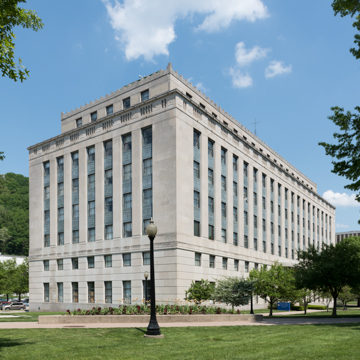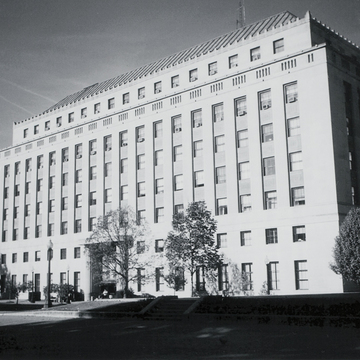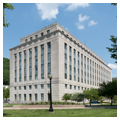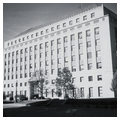You are here
Motor Vehicles Building (State Office Building No. 3)
In October 1945 the West Virginia Review announced that construction of a new state office building would “begin in the spring if there are materials, reasonable prices, and workmen available.” Construction did not begin that spring, nor until several more had passed. Bids were finally opened in November 1949, and the completed building opened in 1952.
Described by the architect as “modified classic,” the building was designed to conform, but not compete, with the state capitol. Eight stories tall, the rectangular structure has a steel framework encased in concrete and is faced in Indiana limestone above a granite base. Window spandrels between the main office stories are faced with Virginia greenstone. The recessed top floor is covered with a prominent hipped roof of standing-seam metal, painted green.
A colorful terra-cotta sculpture at the main entrance, facing the Capitol, contrasts effectively with the clean, unadorned lines of the building. The central figure of the Spirit of West Virginia is surrounded by symbols of the state's natural resources, all on a deep blue background. Paul Jennewein of New York, best known for his earlier work at Rockefeller Center, was the sculptor.
Now housing the Department of Motor Vehicles, this office structure is a handsome, well-thought-out composition that provides a respectful background to the capitol and may well be regarded as a talented son's tribute to his father's greater work. By far the most distinguished of the several buildings that have been added to the complex, it is an important work of an architect whose proper assessment has yet to emerge from the shadow of his famous father.
Writing Credits
If SAH Archipedia has been useful to you, please consider supporting it.
SAH Archipedia tells the story of the United States through its buildings, landscapes, and cities. This freely available resource empowers the public with authoritative knowledge that deepens their understanding and appreciation of the built environment. But the Society of Architectural Historians, which created SAH Archipedia with University of Virginia Press, needs your support to maintain the high-caliber research, writing, photography, cartography, editing, design, and programming that make SAH Archipedia a trusted online resource available to all who value the history of place, heritage tourism, and learning.




